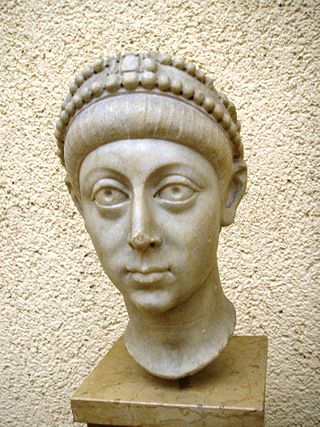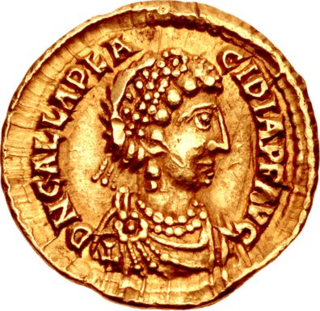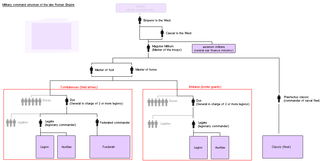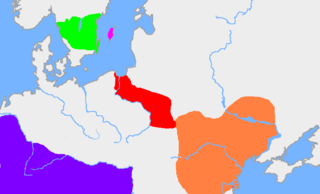Related Research Articles

Arcadius was Roman emperor from 383 to his death in 408. He was the eldest son of the Augustus Theodosius I and his first wife Aelia Flaccilla, and the brother of Honorius. Arcadius ruled the eastern half of the empire from 395, when their father died, while Honorius ruled the west. A weak ruler, his reign was dominated by a series of powerful ministers and by his wife, Aelia Eudoxia.

Galla Placidia, daughter of the Roman emperor Theodosius I, was a mother, tutor, and advisor to emperor Valentinian III. She was queen consort to Ataulf, king of the Visigoths from 414 until his death in 415, briefly empress consort to Constantius III in 421, and managed the government administration as a regent during the early reign of Valentinian III until her death.
Fritigern was a Thervingian Gothic chieftain whose decisive victory at Adrianople during the Gothic War (376–382) led to favourable terms for the Goths when peace was made with Gratian and Theodosius I in 382.

Gratian was emperor of the Western Roman Empire from 367 to 383. The eldest son of Valentinian I, Gratian was raised to the rank of Augustus as a child and inherited the West after his father's death in 375. He nominally shared the government with his infant half-brother Valentinian II, who was also acclaimed emperor in Pannonia on Valentinian's death. The East was ruled by his uncle Valens, who was later succeeded by Theodosius I.

Stilicho was a military commander in the Roman army who, for a time, became the most powerful man in the Western Roman Empire. He was of Vandal origins and married to Serena, the niece of emperor Theodosius I. He became guardian for the underage Honorius. After nine years of struggle against barbarian and Roman enemies, political and military disasters finally allowed his enemies in the court of Honorius to remove him from power. His fall culminated in his arrest and execution in 408.

Magister militum was a top-level military command used in the later Roman Empire, dating from the reign of Constantine the Great. The term referred to the senior military officer of the empire. In Greek sources, the term is translated either as strategos or as stratelates.

Aelia Eudoxia was a Roman empress consort by marriage to the Roman emperor Arcadius. The marriage was the source of some controversy, as it was arranged by Eutropius, one of the eunuch court officials, who was attempting to expand his influence. As Empress, she came into conflict with John Chrysostom, the Patriarch of Constantinople, who was popular among the common folk for his denunciations of imperial and clerical excess. She had five children, four of whom survived to adulthood, including her only son and future emperor Theodosius II, but she had two additional pregnancies that ended in either miscarriages or stillbirths and she died as a result of the latter one.
Bacurius was a Roman general and a member of the royal family of Iberia mentioned by several Greco-Roman authors of the 4th and 5th centuries. It is accepted, but not universally, that all these refer to the same person, an Iberian "king" or "prince", who joined the Roman military ranks. Scholarly opinion is divided whether Bacurius can be identified with one of the kings named Bakur, attested in medieval Georgian annals, who might have taken refuge in territories obtained by the Eastern Roman Empire during the Roman–Persian Wars that were fought over the Caucasus.
Flavius Rufinus was a 4th-century Eastern Roman statesman of Aquitanian extraction who served as Praetorian prefect of the East for the emperor Theodosius I, as well as for his son Arcadius, under whom Rufinus exercised significant influence in the state affairs.

The Theodosian dynasty was a Roman imperial family that produced five Roman emperors during Late Antiquity, reigning over the Roman Empire from 379 to 457. The dynasty's patriarch was Theodosius the Elder, whose son Theodosius the Great was made Roman emperor in 379. Theodosius's two sons both became emperors, while his daughter married Constantius III, producing a daughter that became an empress and a son also became emperor. The dynasty of Theodosius married into, and reigned concurrently with, the ruling Valentinianic dynasty, and was succeeded by the Leonid dynasty with the accession of Leo the Great.
Alatheus and Saphrax were Greuthungi chieftains who served as co-regents for Vithericus, son and heir of the Gothic king Vithimiris.

The Battle of the Frigidus, also called the Battle of the Frigid River, was fought on 5 and 6 September 394 between the armies of the Roman emperor Theodosius the Great and the rebel augustus Eugenius, in the eastern border of Roman Italy. Theodosius won the battle and defeated the usurpation of Eugenius and Arbogast, restoring unity to the Roman Empire. The battlefield, in the Claustra Alpium Iuliarum near the Julian Alps through which Theodosius's army had passed, was probably in the Vipava Valley – with the Frigidus River being the modern Vipava – or possibly in the valley of the Isonzo.

The Valentinianic or Valentinian dynasty was a ruling house of five generations of dynasts, including five Roman emperors during Late Antiquity, lasting nearly a hundred years from the mid fourth to the mid fifth century. They succeeded the Constantinian dynasty and reigned over the Roman Empire from 364 to 392 and from 425 to 455, with an interregnum (392–423), during which the Theodosian dynasty ruled and eventually succeeded them. The Theodosians, who intermarried into the Valentinian house, ruled concurrently in the east after 379.
Justina was a Roman empress. She was initially the wife of the rebel emperor Magnentius and was then married to Valentinian I, with whom she had four children, including the emperor Valentinian II and the empress Galla.
Arbogastes or Arbogast was a Roman army officer of Frankish origin.
The Battle of Pollentia was fought on 6 April 402 (Easter) between the Romans under Stilicho and the Visigoths under Alaric I, during the first Gothic invasion of Italy (401–403). The Romans were victorious, and forced Alaric to retreat, though he rallied to fight again in the next year in the Battle of Verona, where he was again defeated. After this, Alaric retreated from Italy, leaving the province in peace until his second invasion in 409, after Stilicho's death.
Galla was a Roman empress as the second wife of Theodosius I. She was the daughter of Valentinian I and his second wife Justina.

The Greuthungi were a Gothic people who lived on the Pontic steppe between the Dniester and Don rivers in what is now Ukraine, in the 3rd and the 4th centuries. They had close contacts with the Tervingi, another Gothic people, who lived west of the Dniester River. To the east of the Greuthungi, living near the Don river, were the Alans.
Odotheus was a Greuthungi king who in 386 led an incursion into the Roman Empire. He was defeated and killed by the Roman general Promotus. His surviving people settled in Phrygia.
Flavius Timasius was a general of the Roman Empire, a relative of the Empress Aelia Flaccilla, wife of Emperor Theodosius I.
References
- Heather, Peter (2006). The Fall of the Roman Empire: A New History. London: Pan Books. ISBN 0-330-49136-9.
- Philostorgius Historia Ecclesiastica
- Zosimus Nova Historia